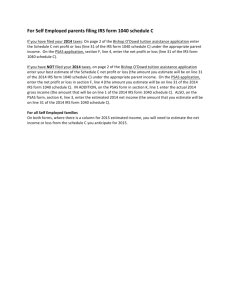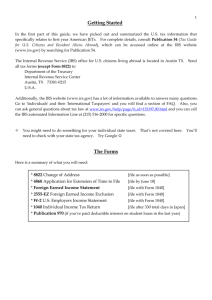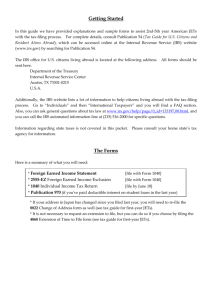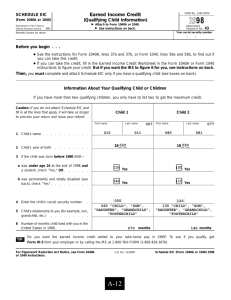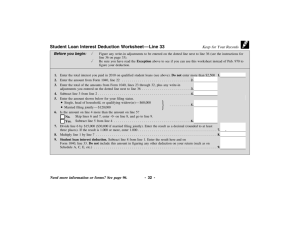2012 Tax Guide for New JETs
advertisement
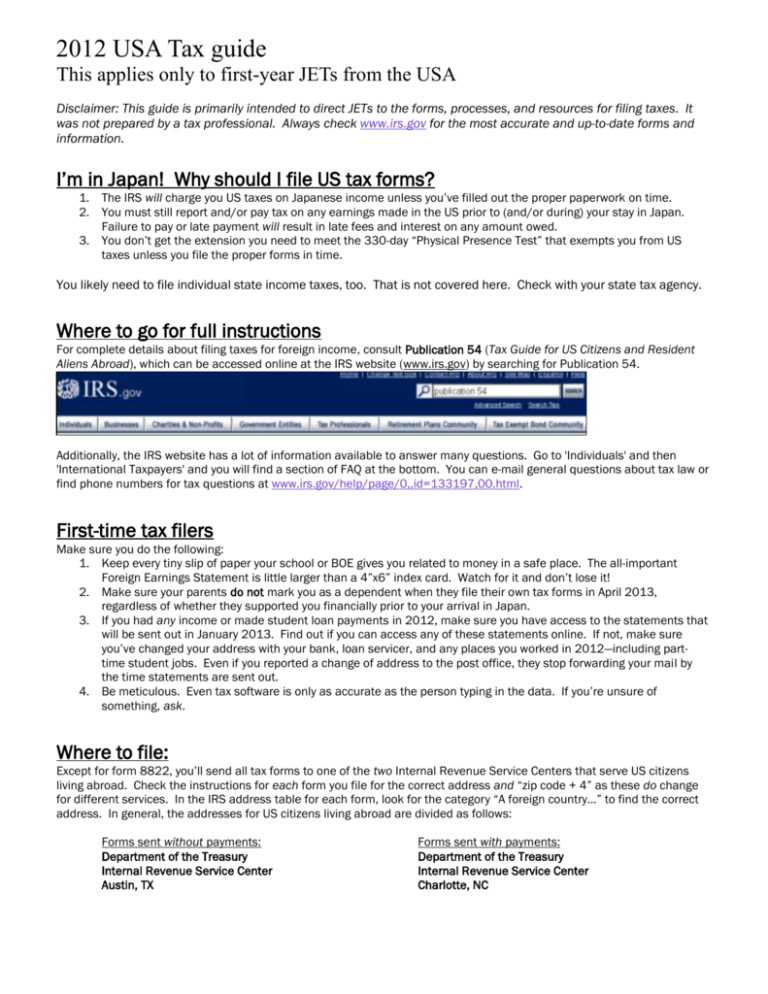
2012 USA Tax guide This applies only to first-year JETs from the USA Disclaimer: This guide is primarily intended to direct JETs to the forms, processes, and resources for filing taxes. It was not prepared by a tax professional. Always check www.irs.gov for the most accurate and up-to-date forms and information. I’m in Japan! Why should I file US tax forms? 1. The IRS will charge you US taxes on Japanese income unless you’ve filled out the proper paperwork on time. 2. You must still report and/or pay tax on any earnings made in the US prior to (and/or during) your stay in Japan. Failure to pay or late payment will result in late fees and interest on any amount owed. 3. You don’t get the extension you need to meet the 330-day “Physical Presence Test” that exempts you from US taxes unless you file the proper forms in time. You likely need to file individual state income taxes, too. That is not covered here. Check with your state tax agency. Where to go for full instructions For complete details about filing taxes for foreign income, consult Publication 54 (Tax Guide for US Citizens and Resident Aliens Abroad), which can be accessed online at the IRS website (www.irs.gov) by searching for Publication 54. Additionally, the IRS website has a lot of information available to answer many questions. Go to 'Individuals' and then 'International Taxpayers' and you will find a section of FAQ at the bottom. You can e-mail general questions about tax law or find phone numbers for tax questions at www.irs.gov/help/page/0,,id=133197,00.html. First-time tax filers Make sure you do the following: 1. Keep every tiny slip of paper your school or BOE gives you related to money in a safe place. The all-important Foreign Earnings Statement is little larger than a 4”x6” index card. Watch for it and don’t lose it! 2. Make sure your parents do not mark you as a dependent when they file their own tax forms in April 2013, regardless of whether they supported you financially prior to your arrival in Japan. 3. If you had any income or made student loan payments in 2012, make sure you have access to the statements that will be sent out in January 2013. Find out if you can access any of these statements online. If not, make sure you’ve changed your address with your bank, loan servicer, and any places you worked in 2012—including parttime student jobs. Even if you reported a change of address to the post office, they stop forwarding your mail by the time statements are sent out. 4. Be meticulous. Even tax software is only as accurate as the person typing in the data. If you’re unsure of something, ask. Where to file: Except for form 8822, you’ll send all tax forms to one of the two Internal Revenue Service Centers that serve US citizens living abroad. Check the instructions for each form you file for the correct address and “zip code + 4” as these do change for different services. In the IRS address table for each form, look for the category “A foreign country…” to find the correct address. In general, the addresses for US citizens living abroad are divided as follows: Forms sent without payments: Department of the Treasury Internal Revenue Service Center Austin, TX Forms sent with payments: Department of the Treasury Internal Revenue Service Center Charlotte, NC The Forms Here is a summary of what you will need: Forms 8822 Change of Address 4868 Application for Extension of Time to File 1040 Individual Income Tax Return (not 1040A or EZ) Foreign Earnings Statement (photocopy) 2555-EZ Foreign Earned Income Exclusion W-2 US Employers Income Statement (original copy) 1099-INT Bank Interest Statement (for reference only) Publication 970 (for reference about student loans only) TDF 90-22.1 Report of Foreign Bank and Financial Accounts Filing (i.e. mailing) date NOW!! By April 15 if you owe tax (June 15 if you don’t) After 330 days in Japan (but fill it out by April 15) (with Form 1040) (with Form 1040) (with Form 1040) By June 30 (if your account ever exceeds $10,000) Form 8822 - Change of Address Send this as soon as possible, if you have not done so already, to notify the IRS of your address in Japan. Informing your embassy or post office will not change your address with the IRS. Check the box for line 1 and enter all relevant information in Lines 3-6. In line 7, enter your Japanese address starting with building name and ending with country and postal code. Skip Part 2 and sign in Part 3. Where you send Form 8822 depends on your former mailing address (see 8822 instructions). JETs with spouses: If your spouse will join you in Japan, include your spouse in the change of address. If, however, your spouse will not join you or returns to work or study in the US without having earned income in Japan, check to see if you would benefit from filing separately. Some long distance couples find splitting shared income and filing separately much simpler than filing jointly when one earns income in the US and the other in Japan. If you choose to file separately, be sure to check this box on 8822 when you establish separate residences. Form 4868 – Extension of Time to File Form 4868 gives you a 6-month extension until October 15 to file the rest of your income tax forms. First year JETs usually must file this extension. The automatic 2 month extension expires June 15, but most JETs won’t reach their 330 day physical presence requirement until late June 24 or later. Fill in your name and Japanese address. For lines 4, 5, and 6, you must fill out a rough draft of Form 1040 to estimate your tax (but do not officially file 1040 until later!). Check the box in Line 8 to indicate that you are a citizen living “out of the country.” If you owe taxes, it’s best to pay the estimated tax amount at the time you file the 4868. Interest will begin to accrue on April 15, so turn in form 4868 (along with an estimated payment) by April 15 if you owe anything. Foreign Earnings Statement This is called the 源泉徴収票 (gensen choushuu hyou) in Japanese. See page 225 of your JET General Information Handbook for a sample copy with translations. This will act as a “W-2” for your income in Japan – reporting what you earned in 2012. If you have not received it yet, ask the accountant in your school or BOE office. You must submit a copy of this with Form 2555EZ. Photocopy the form, write “Foreign Earnings Statement” at the top, and indicate your name and gross income on the photocopy. Write down the US dollars your gross income equaled at the time you earned it: Convert it using the yearly average exchange rate for yen, as listed by the Federal Reserve or the US Embassy in Japan. (The 12/31/12 yearly average rate is ¥79.92.) Write “I used the Federal Reserve Bank’s 2012 yearly average exchange rate of $1:¥79.82 to convert the gross income from yen to US dollars.” Form 2555-EZ – Foreign Earned Income Exclusion This form exempts you from paying US income taxes on the money you earn in Japan. JETs with spouses that have Japanese income: You must fill out a separate form 2555-EZ for each qualifying earner. Part 1 – Almost all new JETs will check “no” in line 1a but “yes” in both line 2a and line 3. The dates you enter in line 2b will usually be the dates you arrived in Japan. The arrival dates for the 2012 incoming JETs are: Group A: July 29, 2012 Group B: August 5, 2012 Group C: August 22, 2012 Part 2 - Fill in your address and employment information; write N/A for Employer's US address. In 9, check "other" and write "foreign local government office." In line 11a write in ALL addresses at which you were taxed last year (home, college, Japan, etc.) and the dates you lived there. Part 3 – Write any dates you were in the US during 2012, along with any income earned during those dates. The date you left the U.S. for Japan should be entered in the second column (“Date left U.S.”) of the top row. You can write N/A in the first column (“Date arrived in U.S.”) of the top row. If you returned to the US anytime in 2012, you must note those dates in Part 3. If you were not on business during those trips to the US, write “0” in columns (c) and (d). Part 4 - Figure your Foreign Earned Income Exclusion. In line 14, where it asks for the number of days in your qualifying period that fall within 2012, subtract the days you were in the US (entered under “Physical Presence Test” on the previous page) from 366. In line 17, enter the US dollar amount you figured on your Foreign Earnings Statement. Form 1040 – Individual Income Tax Return This form reports how much money you earned worldwide in 2012 and how much tax you should pay to the US. It will determine if you get a refund or if you must pay more taxes. You cannot file using the easier forms 1040A or 1040EZ. Remember: DO NOT FILE (i.e. do not mail in) form 1040 until after you meet the 330 day physical presence test from 2555EZ. However, do fill out form 1040 by April 15 to estimate any tax you might owe. You must pay estimated tax by April 15 or else pay penalties and interest when you file later. There are a lot of specific questions on the Form 1040 that will be different for each person. This section discusses only the specific parts related to living and working in Japan. For the rest of the form, it’s best to start at the top and work your way through the instructions line by line. Consult a certified tax preparer and/or the official IRS site and form instructions to be sure you don't miss something. Label & Exemptions – Enter your name, Japanese address, social security #, and filing status. Check box 6a for yourself. Income – For line 7, “wages, salaries, and tips,” enter the grand total (all W-2s and your Japanese income). In line 8a, include interest earned on savings accounts, reported by your bank on Form 1099-INT. List your Japan-earned income in parentheses on the “Other Income” line, and write “2555-EZ” next to it. Add up all your income (lines 7 to 21) but subtract the Japan-earned income amount. Enter the total on the next line. This total is the amount of taxable income you earned during 2012. For example, if you earned $5,000 in the US, $13,735 in Japan, and $30 US bank interest: Adjusted Gross Income – Most of this section will be zeros, but read all the instructions to be sure. New JETs may have questions about these items: * Educator Expenses – You cannot claim JET-related expenses, as they are related to your excluded Japanese income. * Moving Expenses – You cannot claim JET-related moving expenses. IRS considers them related to your excluded income. * Student Loan Interest Deduction – Enter the amount of the “Student Loan Interest Deduction” from the worksheet in IRS Publication 970. Many student loan servicers provide this information to you directly. Check online to see if the student loan interest is already figured out for you. Line 44 – You must use the “Foreign Earned Income Tax Worksheet—Line 44” (found in the instructions for 1040) to calculate your tax. For lines 4 and 5 you will have to consult the Tax Table further on in the instructions booklet. You cannot simply use the raw tax table amount listed for the taxable income in line 43. I thought my foreign income was excluded from US taxes. So why does the Foreign Earned Income Tax Worksheet tax me at a higher amount than the tax table shows for my US-related income? The US has a progressive tax rate, which means that (in theory, at least) the US charges low taxes to citizens with low income, and raises tax rates as income rises. The purpose of the Foreign Earned Income Tax Worksheet is to ensure that you are taxed at a rate that is fair for your combined US/Japan income, since you are not, in fact, as desperately poor as your US-based income alone might suggest. Don’t worry: The dollar amount of tax you pay will be much lower than someone who earned the same US-source income as your combined income, but the percentage at which your US-based income is taxed will be the same. Finishing Form 1040 – Complete the remainder of Form 1040 and calculate if you owe tax or will be sent a refund. In the box titled “your occupation” enter “English Teacher” (ALT) or “Coordinator for International Relations” (CIR). Filing Form 1040 – File only after you have been in Japan for 330 days (but before October 15). Make sure you sign and date the forms and mail them all to the appropriate IRS Center. Your return will include at least Forms 1040, 2555-EZ, the Foreign Earned Income Statement, and W-2s if you were employed before JET.
